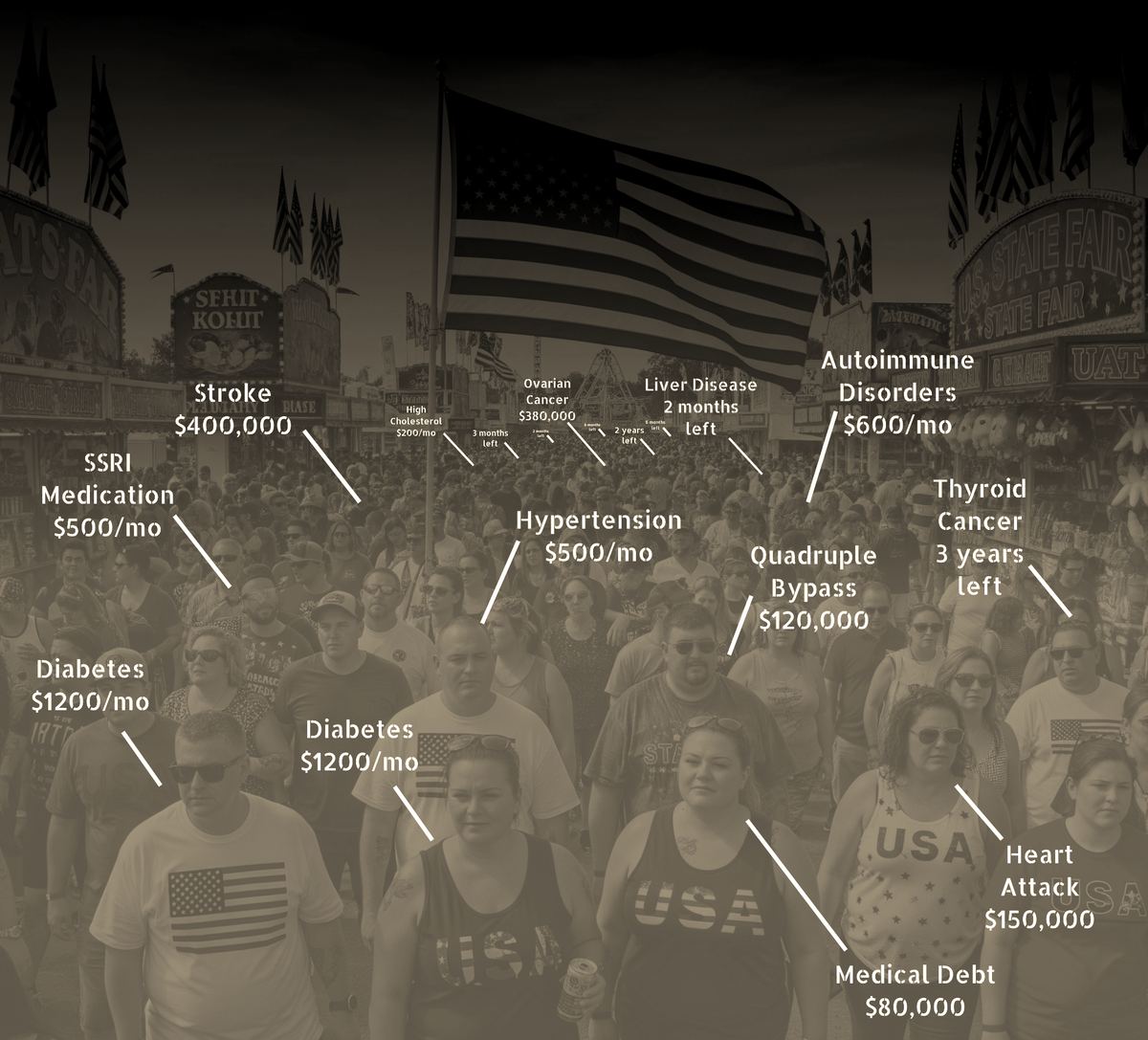By the Numbers

The United States, despite its wealth and advanced medical infrastructure, faces a troubling reality: its health outcomes lag behind many other developed nations. From life expectancy to chronic disease prevalence and pandemic mortality, the numbers paint a grim picture of American health.
“For many years, Americans have been dying at younger ages than people in almost all other high‑income countries.”
— The Atlantic, “Living Sick and Dying Young in Rich America,”
Life Expectancy and General Health
The U.S. trails its peers in life expectancy, a fundamental measure of population health. The 2013 report, U.S. Health in International Perspective: Shorter Lives, Poorer Health, found that U.S. males lived 3.7 years less than Swiss males, and U.S. females lived 5.2 years less than Japanese females, a gap that has widened over decades, particularly for women. More recent data from 2022 shows the U.S. with the lowest life expectancy at birth among 12 high-income countries, alongside the highest rates of avoidable deaths, maternal and infant mortality, and suicides.
Chronic conditions exacerbate this disadvantage. The U.S. has the highest prevalence of multiple chronic illnesses and obesity. These factors contribute to a "sick care" system, where research spending fails to translate into healthier lives.
Obesity
The obesity epidemic in the U.S. is a driving force behind this health crisis. In 2021, 41.9% of adults were obese (BMI ≥ 30), a significant rise from 30.5% in 2000, according to the CDC¹. Among children and adolescents aged 2–19, 19.7% (14.7 million) were obese in 2017–2020, with 6.1% experiencing severe obesity². This epidemic contributes to an annual economic burden of $147 billion³, driven by conditions like hypertension (49% of adults) and osteoarthritis (31% of adults over 45)⁴. The U.S. obesity rate is nearly double the OECD average⁵, with poor dietary habits—57% of calories from ultra-processed foods (The BMJ, 2019)⁶—fueling metabolic disorders and increasing the need for costly interventions like quadruple bypass surgery, averaging $140,000–$150,000 in 2025⁷.
Chronic Illness
Chronic diseases further compound the crisis. In 2021, 60% of U.S. adults had at least one chronic condition, and 40% had two or more, per CDC data⁸. Heart disease, the leading cause of death, affected 7.1% of adults (18.2 million) and caused 695,547 deaths in 2022⁹. Type 2 diabetes prevalence reached 14.7% (37.3 million adults) in 2021, with 352,000 deaths linked to complications¹⁰. Cancer incidence stood at 439 per 100,000, with 1.9 million new cases in 2022 (NCI)¹¹. Chronic kidney disease impacted 14% of adults (35 million) in 2020, often tied to dietary factors and hypertension¹². These conditions strain the $4.5 trillion healthcare system¹³, highlighting a gap in preventive care compared to nations with lower chronic disease rates.
COVID-19: A Magnifying Glass

The COVID-19 pandemic exposed and amplified these health challenges. By May 2, 2023, the U.S. recorded over 104.5 million cases and 1.1 million deaths, the highest globally. This translates to a death rate 63% higher than other wealthy nations since the Omicron variant emerged in December 2021¹⁵. In 2020 and 2021, COVID-19 became the third leading cause of death in the U.S., surpassing combined deaths from influenza, strokes, suicides, and car crashes in a typical year.
Excess deaths—those above expected levels—further highlight the toll. From 2020 to 2021, the U.S. saw over 930,000 excess deaths, ranking behind India, Russia, and Indonesia globally but among the highest per capita among developed nations at 140 per 100,000 people, far above the global average of 96¹⁶.
Mental Health and Substance Use

The pandemic worsened mental health and substance use crises. Drug overdose deaths rose 50% from 2019 to 2021, reaching 107,622 in 2021¹⁷. Alcohol-induced deaths surged 35% higher, totaling 54,258 in 2021¹⁸. Suicide rates, after a two-year decline, increased 4.7% in 2021, the largest single-year rise in two decades, with 48,183 deaths¹⁹. The toll deepened with 50.4% of adults reporting anxiety or depression in 2023, up from 41.5% in 2019 (CDC)²⁰, and 20.9% of adolescents aged 12–17 experiencing major depressive episodes in 2022 (NSDUH)²¹. Among youth, 42% reported persistent sadness or hopelessness²², reflecting a youth mental health crisis.
Substance use disorders, linked to 107,622 overdose deaths in 2021, highlight a growing addiction crisis, with opioid-related deaths alone rising 30% since 2019 (NIH)²³. Globally, 93% of countries reported disrupted mental health services during the pandemic, but the U.S. faced unique challenges due to a mental health workforce shortage affecting 47% of its population²⁴. In 2023, 27% of adults with mental health conditions received no treatment due to provider shortages or access barriers (Kaiser Family Foundation)²⁵. Telehealth expansions helped, but long wait times and outdated directories hindered care, exacerbating isolation and stress²⁶.
What can you do?

The time is now. We must change as a nation and this change starts with you.
Start where you are. Get your own health in order. Bring a friend. Start a group. Confronting this crisis starts with you.
A stronger America needs a stronger you. Join today!
Sources
¹ Centers for Disease Control and Prevention. (2021). Adult Obesity Facts. [https://www.cdc.gov/obesity/data/adult.html]
² Centers for Disease Control and Prevention. (2020). Childhood Obesity Facts. [https://www.cdc.gov/obesity/data/childhood.html]
³ Finkelstein, E. A., et al. (2014). Obesity and Severe Obesity Forecasts Through 2030. American Journal of Preventive Medicine. [https://www.ajpmonline.org/article/S0749-3797(14)00162-8/fulltext]
⁴ Centers for Disease Control and Prevention. (2022). Hypertension Prevalence. [https://www.cdc.gov/bloodpressure/facts.htm]
⁵ Organisation for Economic Co-operation and Development. (2023). Obesity Update. [https://www.oecd.org/health/obesity-update.htm]
⁶ Steele, E. M., et al. (2019). Ultra-processed foods and added sugars in the US diet. The BMJ. [https://www.bmj.com/content/365/bmj.l1949]
⁷ Medical Tourism Association. (2021). Heart Bypass Surgery Cost. [https://www.medicaltourism.com/articles/heart-bypass-surgery-cost]
⁸ Centers for Disease Control and Prevention. (2021). Chronic Disease Overview. [https://www.cdc.gov/chronicdisease/about/index.htm]
⁹ Centers for Disease Control and Prevention. (2022). Heart Disease Facts. [https://www.cdc.gov/heartdisease/facts.htm]
¹⁰ Centers for Disease Control and Prevention. (2021). National Diabetes Statistics Report. [https://www.cdc.gov/diabetes/data/statistics-report/index.html]
¹¹ National Cancer Institute. (2022). Cancer Statistics. [https://www.cancer.gov/about-cancer/understanding/statistics]
¹² Centers for Disease Control and Prevention. (2020). Chronic Kidney Disease in the US. [https://www.cdc.gov/kidneydisease/publications-resources/2019-national-facts.html]
¹³ Centers for Medicare & Medicaid Services. (2021). National Health Expenditure Data. [https://www.cms.gov/Research-Statistics-Data-and-Systems/Statistics-Trends-and-Reports/NationalHealthExpendData]
¹⁴ World Health Organization. (2023). COVID-19 Dashboard. [https://covid19.who.int/]
¹⁵ Johns Hopkins University. (2023). COVID-19 Mortality Analyses. [https://coronavirus.jhu.edu/data/mortality]
¹⁶ The Economist. (2021). Excess Mortality Estimates. [https://www.economist.com/graphic-detail/coronavirus-excess-deaths-estimates]
¹⁷ Centers for Disease Control and Prevention. (2021). Drug Overdose Deaths. [https://www.cdc.gov/drugoverdose/deaths/index.html]
¹⁸ National Institute on Alcohol Abuse and Alcoholism. (2021). Alcohol-Related Deaths. [https://www.niaaa.nih.gov/publications/brochures-and-fact-sheets/alcohol-facts-and-statistics]
¹⁹ Centers for Disease Control and Prevention. (2021). Suicide Mortality in the US. [https://www.cdc.gov/suicide/facts/index.html]
²⁰ Centers for Disease Control and Prevention. (2023). Mental Health Household Pulse Survey. [https://www.cdc.gov/nchs/covid19/pulse/mental-health.htm]
²¹ Substance Abuse and Mental Health Services Administration. (2022). National Survey on Drug Use and Health. [https://www.samhsa.gov/data/report/2022-nsduh-annual-national-report]
²² Centers for Disease Control and Prevention. (2023). Youth Risk Behavior Survey. [https://www.cdc.gov/healthyyouth/data/yrbs/index.htm]
²³ National Institutes of Health. (2023). Opioid Overdose Crisis. [https://nida.nih.gov/research-topics/opioid-overdose-crisis]
²⁴ World Health Organization. (2021). Mental Health Atlas. [https://www.who.int/publications/i/item/9789240036703]
²⁵ Kaiser Family Foundation. (2023). Mental Health Care Access. [https://www.kff.org/mental-health/issue-brief/the-unmet-need-for-mental-health-care/]
²⁶ American Psychological Association. (2023). Telehealth and Mental Health. [https://www.apa.org/monitor/2023/01/trends-telehealth-mental-health]





